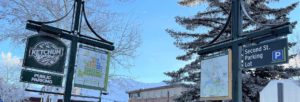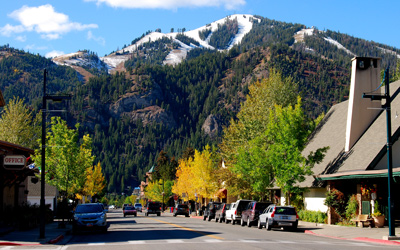
Parking Management Plan
How and why does Ketchum manage parking?

Ketchum’s parking management plan was created in December 2022 by Dixon Consulting, using research, best practices, and parking management principles incorporated by comparable mountain resort communities. It has since been evaluated during community focus groups and City Council and Ketchum Urban Renewal Agency meetings in 2023. The plan utilizes an industry-standard 85% parking occupancy goal during peak times of use. This rate ensures enough vacancies (at least one parking space per block at all times) so drivers aren’t burdened while making sure parking spaces don’t go unused—taking resources away from other needs. Parking surveillance was introduced to monitor Ketchum’s parking use. Some parking spaces in high-demand areas were converted to short-term parking (two hours or less) to create more turnover and supply.
The takeaway: Ketchum has 2,164 total public parking spaces. This is two to nearly four times more inventory per capita than all but one comparable mountain resort town. There is adequate parking supply in Ketchum to accommodate residents, visitors, and commuters, provided drivers park in spaces designed for their use.
Parking is a vital, finite resource, competing for space and funding alongside other elements supporting the vision and values outlined in Ketchum’s Comprehensive Plan. As with other needs—roadways, housing, utilities, and emergency services, to name a few—inadequate amounts strain the community. So does overabundance. Parking is part of an ecosystem. Undersupply may mean drivers suffer. Oversupply impacts housing development, green spaces, and community character. A balanced parking plan identifies the community’s priorities and threads the needle, giving just
enough parking supply to support our needs.
Priorities shaping the Parking Management Plan
Values
- Strong, diverse economy
- Vibrant downtown
- Community character
- Variety of housing options
- Environmental quality and scenic beauty
- Exceptional recreational opportunities
- Well connected community
- Enlivened by arts and culture
- ‘Greener’ community
- Working as a region
Vision
We aspire to be an authentic mountain community with world class character, yet small-town feel. We see our community as one with a high quality of life for a local year-round population and a visiting population. We will be successful by creating, marketing, and delivering distinctive choices for jobs, learning, health, outdoor adventure and arts and culture. We value a strong sense of community. Furthermore, we wish to be a place with a strong economy, a vibrant downtown, diverse options for housing, and a varied demographic of people who live, work, and visit here. We will be responsible stewards of our environment, work for a dynamic economy, and maintain our special way of life for generations to come.
2014 Comprehensive Plan
Do your part to support healthy inventory by parking in spaces designed for you!
Short-term parking (two hours or less)
Customer parking (identified by the community as a priority)
Ketchum’s parking plan prioritizes customer parking—our economy depends on it! Only customers should use short-term parking to ensure they have the shortest possible walking
distance to storefronts and businesses.
Long-term parking (unrestricted)
Employee parking
Employees should always park in long-term spaces, even if it’s a block or two away. Otherwise, you’re using a customer’s space and hurting your (and fellow business’) bottom line.
Resident parking
Most residential buildings are required by city code to include on-site parking, with some exceptions dependent on residence type, size, and zoning district location. Residents should only use
long-term parking if they must use public parking spaces.
Timeline
The parking management plan is being developed alongside the Comprehensive Plan and Code Update project. Feedback collected, and subsequent plan drafts created from, the Comprehensive Plan revamp will guide the direction of the final Parking Management Plan.
Are parking spaces being reduced in Ketchum?
Slightly. Out of 2,164 total spaces, Main Street improvements will result in 25 fewer spaces, and the
First and Washington Redevelopment project will replace 66 spaces. Additional residential parking
may be added as part of the First and Washington Redevelopment project, depending on costs and
residents’ needs.
Can public parking spaces be added in town?
Yes. However, current parking use data suggests it is not needed and that parking enforcement (making sure drivers are using short-term vs. long-term parking appropriately) in high-use areas would work just as well while costing much less. Additional parking lots or garages have been explored. Proposals so far have either cost too much to justify the benefits, the logistics would not work, or they undermine other Ketchum values and priorities. More research is underway to determine options.
Is parking being provided for downtown residential developments, such as
Bluebird Village or the First and Washington Redevelopment project?
Yes. Most new developments are required to provide on-site parking, with some exceptions dependent on residence type, size, and zoning district locations. For instance, Bluebird Village includes 46 parking spaces. The number of spaces included in the First and Washington Redevelopment project is still being determined, considering residents’ needs vs costs.
What parking changes are being considered and how will they affect me?
Underutilized parking could be converted from long-term (all day) to short-term (two hours or less)
parking to ensure customers don’t have to walk more than one or two blocks to access businesses.
More drop-off spaces in high-volume areas may also be considered. Increased monitoring of
parking use and data collection throughout town will also be taking place to help evaluate if changes
need to be made. The development of parking structures and lots may also be explored. However,
current parking use data suggests their cost would not be worth their benefits. In the meantime,
parking enforcement in high-use areas will help ensure enough parking supply. We can all do our
part to ensure there is enough supply by parking in spaces designated for our specific use—
customers in short-term (two hours or less) spaces and employees and residents in long-term
(unrestricted) spaces.